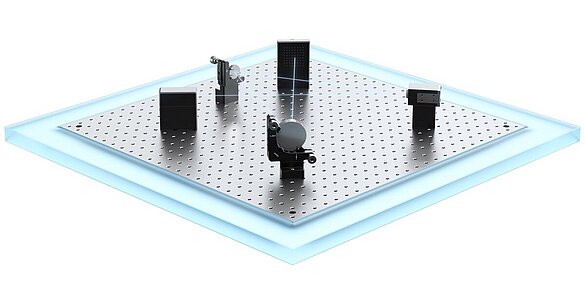Free Space Optical Communication
Fast Steering Mirrors for Laser Beam Control
As an alternative to fiber optic cables, several technology companies are working on deploying extensive low earth orbit space-based communications networks. Compact satellites acting as their nodes are launched into orbit, utilizing laser light to connect to each other, and efficiently transmit data across the globe. On Earth, a comparable method of establishing secure point-to-point networks even in densely populated areas is emerging through the use of “fiberless photonics.”
Piezoelectric or electromagnetic Fast Steering Mirrors (FSM) from PI provide angular resolution down to the nanorad scale with a mechanical bandwidth reaching up to the kHz range. These mirrors effectively compensate for common disturbances in various applications. While piezo-driven FSMs offer a higher resolution and bandwidth, electromagnetic units (usually voice coil FSMs) allow larger displacements. PI’s solutions are based on the ability to scale up quickly to large quantities and on the adaptation of standardized tip/tilt systems to meet specific customer needs.
Fast Piezo Steering Mirror Platform
- Tip/tilt angle up to 5 mrad, optical deflection angle up to 10 mrad
- Differential drive for increased stability
- Two orthogonal tip/tilt axes with common center of rotation
- High resonant frequencies to 10 kHz (0.5″ mirror) for dynamic motion
- and fast step-and-settle
- Parallel kinematics design provides identical high dynamics of both axes
- Ultra-compact design
- Durable and friction-free thanks to flexures
- Sensors for high linearity in closed-loop operation
- For mirrors up to Ø 12.7 mm (0.5″)
- Mars-rover tested PICMA® piezo actuators and flexure guides
>> S-331 High-Speed Tip/Tilt Platform
Fast Voice Coil Steering Mirror Platform
- Tip/tilt angle up to 4°, optical deflection angle up to 8°
- Differential drive for increased stability
- Two orthogonal tip/tilt axes with common center of rotation
- Parallel-kinematic design providing identical high dynamics of both axes
- Compact design
- Durable and friction-free thanks to flexures
- Optical encoders for high precision closed-loop operation
- Custom designs for space applications
>> V-931 High Dynamics PIMag® Voice Coil Tip/Tilt Platform
Haben Sie Fragen zu unseren Lösungen? Unsere Spezialisten helfen Ihnen gerne weiter!
Kontakt aufnehmen!
